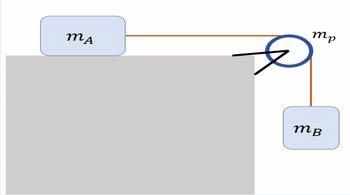Drop-load (I)
Context
We want to lower a suspended load in a controlled way so that it hits the ground with a speed whose modulus is not too great. To do this, the suspended load (B) is connected by a rope passing through a pulley to another mass (A), which can move on a horizontal surface.
Information
The masses of the charges A and B are known.
The pulley is a ring of mass mp and radius R that can rotate without friction.
The surface on which mass A is placed is horizontal.
There is no friction between mass A and the surface on which it is placed.
The string attached to mass A is perfectly parallel to the surface on which the mass is resting.
Schematization
Draw a diagram of each object that interests us. Draw your x- and y-axes for each object. Draw and name each force experienced by each object that interests us.
Modelization
Creates a model for the acceleration of mass B given the known parameters of the problem that are relevant.
Then test your model with the following values
Mass of the load A: 80kg;
Mass of suspended load (B): 71kg;
Pulley mass (mp): 55kg
Pulley radius: 0.64m

Step by stepSolved in 3 steps

- < 8 of 18 Exercise 13.35 an Review I Constants A thin spherical shell has radius rA = 3.00 m and mass mA = 35.0 kg. It is concentric with a second thin spherical shell that has radius TB =7.00 m and mass mg = 60.0 kg Part A What is the net gravitational force that the two shells exert on a point mass of 0.0200 kg that is 2.00 m from the common center of the two shells (inside both shells)? Express your answer with the appropriate units. HÀ ? F= Value Units Submit Request Answer • Part B What is the net gravitational force that the two shells exert on a point mass of 0.0200 kg that is 5.00 m from the common center of the two shells (in the space between the two shells)? Express your answer with the appropriate units. HÀ F = Value Units Submit Request Answer • Part C What is the net gravitational force that the two shells exert on a point mass of 0.0200 kg that is 8.00 m from the common center of the two shells (outside both ahelle2 MacBook Air DII 80 888 F10 F11 F12 F7 esc F3 F4 F5 F6…arrow_forwardI need the answer quicklyarrow_forwardApply error propagation to determine the associated uncertainty in the average volume… Plzarrow_forward
- The answer must be in Handwritten format, Don't use chatgpt. Free body diagram must be includedarrow_forwardCoulomb's Law A thin rod of length L, oriented in the x-direction, has charge +Q. The rod lies on the floor. The left end of the rod is touching a wall. On the floor, a small frictionless puck of mass M and charge Q is also touching the wall. The puck is a distance b from the left end of the rod. If the wall were removed, the puck would slide at an angle. But the wall constrains the puck to slide only in the y-direction. Here, the y-direction is not vertical. It's along the floor, perpendicular to the rod. a. What is the puck's acceleration, immediately after it's released? Hint: The wall constrains the puck to accelerate only in the y-direction. Therefore, you need to worry only about the y-directed forces. If you can't complete the math, that's OK; but set things up completely. Top down view Base of wall Puck b. What normal force does the wall exert on the puck when the puck is first released? Hint: The normal force, which points in the x-direction, must cancel the x-component of the…arrow_forwardDrop-load (III) context We want to lower a suspended load in a controlled way, so that it hits the ground with a speed whose modulus is not too great. To do this, the suspended load (B) is connected by a rope passing through a pulley to another mass (A), which can move on an inclined surface. Information The masses of charges A and B are known.The pulley is a solid cylinder (or disc) of mass mp and radius R which can turn without friction.The surface on which mass A is placed is horizontal.There is friction between mass A and the surface on which it is placed, the coefficient of friction is uc.Mass A is on a surface tilted by an angle delta.The rope attached to mass A is perfectly parallel to the surface on which the mass is placed. Schematization Draw a diagram of each object that interests us. Draw your x and y axes for each object. Draw and name each force experienced by each object that interests us. Modelization Create a model for the acceleration of mass B given the known…arrow_forward